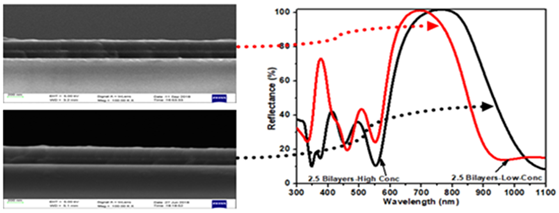NANOSYSTEMS: PHYSICS, CHEMISTRY, MATHEMATICS, 2019, 10 (3), P. 355–360
Morphological and optical properties of dielectric multilayer structures prepared with distinct precursor concentrations
Venkatesh Yepuri – Department of Nanotechnology, Swarnandhra College of Engineering and Technology, Seetharampuram, Narsapur (A.P.); Amity Institute of Nano Science and Technology, Amity University, Gurgaon, (Haryana), India
R. S. Dubey – Department of Nanotechnology, Swarnandhra College of Engineering and Technology, Seetharampuram, Narsapur (A.P.), India; rag_pcw@yahoo.co.in
Brijesh Kumar – Amity Institute of Nano Science and Technology, Amity University, Gurgaon, (Haryana), India
For optical filters, TiO2 and SiO2 films are better choices due to their large refractive index contrast. In spite of the various available techniques, the sol-gel spin coating method is one of the easiest and inexpensive technique. Here, we report the experimental studies of (TiO2/SiO2)2.5 bilayer-based structures prepared with two distinct precursor concentrations. FTIR analysis showed the characteristic vibration peaks of the Ti-O-Ti and Si-O-Si bonds. XRD measurements of both the samples based on the low and high-precursor concentrations, revealed the dominant peaks of TiO2-anatase phase. FESEM study endorsed the increased thicknesses of the individual layers due to enhanced precursor concentrations. Both samples evidenced for the reflection/stop bands with 100% reflectivity. Furthermore, multilayer structure of (TiO2/SiO2)2.5 bilayers showed the corresponding shift of the reflection band from the visible-infrared wavelength region in accordance with the low-high precursor concentration. This shifting of the reflection band is attributed to the increased thicknesses of the films which is due to the enhanced grains size as confirmed by the AFM studies.
Keywords: reflectors, multilayers structures, cross-section SEM morphology, precursor concentration.
DOI 10.17586/2220-8054-2019-10-3-355-360
